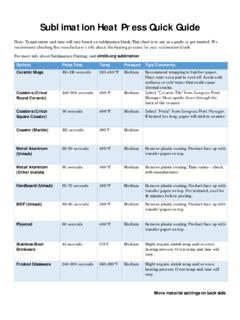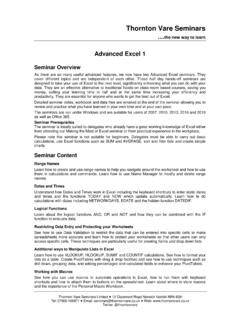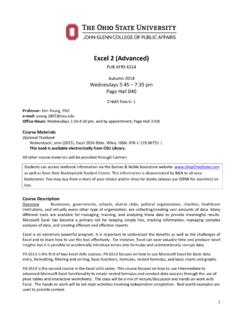Transcription of Advanced Excel: Pivot Tables - elmhurstpubliclibrary.org
1 1 Welcome to Advanced excel : Pivot Tables . I m sure you re excited to get started on your journey into the depths of Microsoft excel . In this course we will cover: Pivot Tables Creating Formatting Sorting & Filtering Printing Of course, we do have some expectations about what you already know. In order to get the most out of this class, you will need to feel comfortable: Using Windows Using excel 2013 and the ribbon Switching between worksheets Copying and Pasting Using formulas in excel Using the right mouse button for context menus Throughout this course we will use several practice files. These files can be found posted on the Elmhurst Public Library website. Each section header will list any files that are used by indicating the file name below the section title. What is a Pivot Table? A Pivot table is a tool that is part of Microsoft excel (and other spreadsheet applications, like Google Sheets) that helps users not only to quickly view and analyze data in a more visual way, but also to just as easily change the arrangement of the data so that it can be seen from multiple perspectives.
2 It is, Advanced excel : Pivot Tables 2 surprisingly, one of the most feared features of excel , but as you ll quickly discover, Pivot Tables are easy to make, fun to use, and extremely helpful and informative. Originally, if you wanted to take a collection of data and make an attractive and useful presentation out of it, you needed to spend a lot of time copying, pasting, writing formulas, and formatting the result. Pivot Tables help you to accomplish this in just a few clicks. Preparing Your Data: File: Before you can make a Pivot table, you need data. Your data needs to be arranged in a list or table format. Each column of your data will have a column header or title. So, if your data is a list of how many customers buy products that your company sells to over time, you might have a column for year, quarter, product, and customers (see figure 1).
3 3 Figure 1: Data for Pivot Table In order for this data to work for a Pivot table, you should have: No blank rows or columns, No data outside of the list (in other rows or columns), and (to repeat) Each column should have a header. Finally, it is best if your list of data is actually formatted as a table. By formatting your data as a table, you will be able to add to the data and have it easily incorporated into the Pivot table. Without formatting as a table, you would need to redefine your Pivot table every time you add new data. 4 If your data is not already formatted as a table, simply click on a cell inside of your data and then choose Table from the Insert tab in the ribbon (see figure 2). Figure 2: Format as a Table Creating Your First Pivot Table: To make a Pivot table: 1. click on a cell in your table of data, 2. Choose PivotTable from the Insert tab on the ribbon (see figure 2).
4 Figure 3: Create PivotTable Dialogue Box excel will give you a dialogue box (see figure 3) asking you to define your source data and where you want the Pivot table to appear in your workbook. Because you clicked inside of your data table first, excel should already correctly list your source data as the name of your data table ( , Table1 ). You can also choose 5 which worksheet the table will be placed into. In this case, we will leave it as New Worksheet. After making these 2 selections, click OK and your Pivot table will be created (see figure 4). Figure 4: Empty Pivot Table What you re looking at now is a Pivot table that is displaying no data. To add data, click on the Pivot table and the Pivot Table Fields Pane will appear on the right side of your excel Window (see figure 5). 6 Figure 5: Pivot Table Fields Pane (right) The Pivot Table Fields Pane appears when you click on the Pivot table.
5 It has a listing of each of your data fields (columns from your table) at the top. At the bottom of the pane are the areas into which you will place the data fields. We will skip Filter for now and focus on Rows, Columns, and Values. You can place the data fields into the rows, columns, and values either by dragging them into the area or by clicking the checkbox next to the data field. If you click the checkbox, excel will choose into which area the data field will be placed. For now, we will drag the data field, Year, to the Rows area, Quarter to Rows as well, Product to the Columns area and Customers to the 7 Values area. This results in the table you see in figure 6. Note that you can drag any of those fields to any of the areas and get a table with a different appearance. Also note that if you drag Quarter above Year in the rows area, it also impacts the arrangement of the table.
6 Figure 6: Pivot Table Created and Filled You have now successfully made your first Pivot table. Congratulations! Recommended Pivot Tables : File: Since you are new to Pivot Tables , you might find it informative and useful to try the Recommended PivotTables button on the Insert ribbon (figure 7). This feature allows you to see many of the possible Pivot Tables your data can 8 generate. Make sure to click in your original table of data before clicking the Recommend PivotTables button. Figure 7: Recommended Pivot Tables Button Exploring Pivot Tables : File: Now that we ve made a few Pivot Tables , let s look at some of their features and menus. To begin with, in order to access the menus and commands associated with a Pivot table, you have to click somewhere inside of the Pivot table. Once you do that, you will see the Pivot Tables field pane appear on the right and the Pivot table tabs appear on the top of the ribbon (see figure 8).
7 You always need to have selected a cell inside of your Pivot table to access these features. You ll notice that the two Pivot table tabs on the ribbon are called Analyze and Design. The Analyze tab has commands relating to the content and arrangement of the table and the commands in the Design tab relate to formatting the Pivot table. 9 Figure 8: Pivot Tables Field Pane (right) and Pivot Tables Analyze and Design Tabs (top) 10 Figure 9: Pivot Table Parts Subtotals and Grand Totals: By default each Pivot table has both subtotals and grand totals. In the case of Figure 9, grand total rows and columns are labeled and subtotal rows are in line with the years. Collapsing Rows: If you look at the rows in the Pivot table in Figure 9, you see the - icon next to both 2013 and 2014. You can click the - icon and it will collapse all of the quarters under that year.
8 Figure 10 shows what happens after clicking both of the - icons. 11 Figure 10: Collapsed Rows Once you ve collapsed the rows, the - icon changes to a +. If you click the + icon then the rows expand back to normal like in Figure 9. Sorting and Filtering: Also in your Pivot table (see Figure 9), you find the pulldown icon () next to Row Labels and Column Labels. Clicking the pulldown icon will bring up several options for sorting and filtering the Pivot table. We will cover these later in the course. Cleaning Up Clutter: Because the +/- buttons, the row and column labels, the pulldown icons and the PivotTable Fields Pane do to some degree clutter up the screen and the table, all of these can be easily turned on and off from the Analyze Tab (see Figure 11). Figure 11: Buttons to add/remove some of the clutter Adding New Data: Data can be added to the Pivot table by simply going to the original data table and either amending the data you wish to amend or adding new rows or columns.
9 The changes will not be immediately incorporated into the Pivot table until you use the Refresh button under the Analyze tab (see Figure 12). 12 Figure 12: Refresh Button Renaming Pivot Tables and Fields: You can easily rename both the Pivot table and the fields by giving them a new name in the PivotTable Name and Active Field entry boxes on the ribbon under the Analyze tab (see Figure 13). Rename your Pivot table by typing a new name in the PivotTable Name box. To rename fields, click on the field that you want to rename and then type the name you wish to use in the Active Fields box. Figure 13: Renaming Pivot Tables and Fields Selecting, Copying, Pasting, and Deleting Pivot Tables : In order to copy or delete a Pivot table, you need to first select it. To select a Pivot table, simply click in the Pivot table and then choose Select Entire PivotTable from the ribbon under the Analyze tab (see Figure 14).
10 Figure 14: Select Entire PivotTable Once you ve selected the entire Pivot table, you can then copy and paste it anywhere you like in the same way that you d cut and paste anything in excel . Keep in mind that each copy of a Pivot table is independent of the original. 13 To delete a Pivot table, simply select the entire table as described above and then hit the delete button. Clear Pivot Table: You may, for whatever reason, want to clear the Pivot table back to the original empty state. This is easily done by clicking on the Pivot table and then choosing Clear Clear All from the ribbon under the Design tab (see Figure 15) Figure 15: Clear Pivot Table Using an External Data Source: File: New Blank Workbook plus The source data for a Pivot table can come from outside the excel workbook. Your data source is chosen from the Create PivotTable Dialogue box which was shown earlier in Figure 3.













